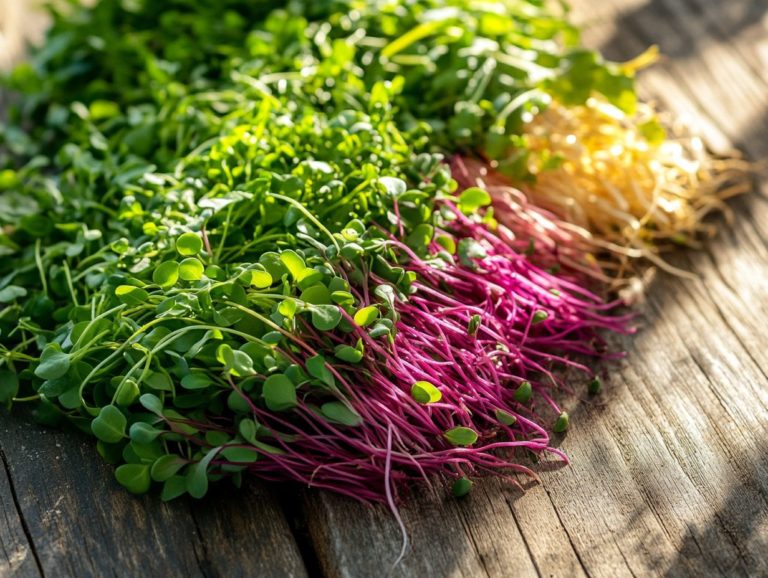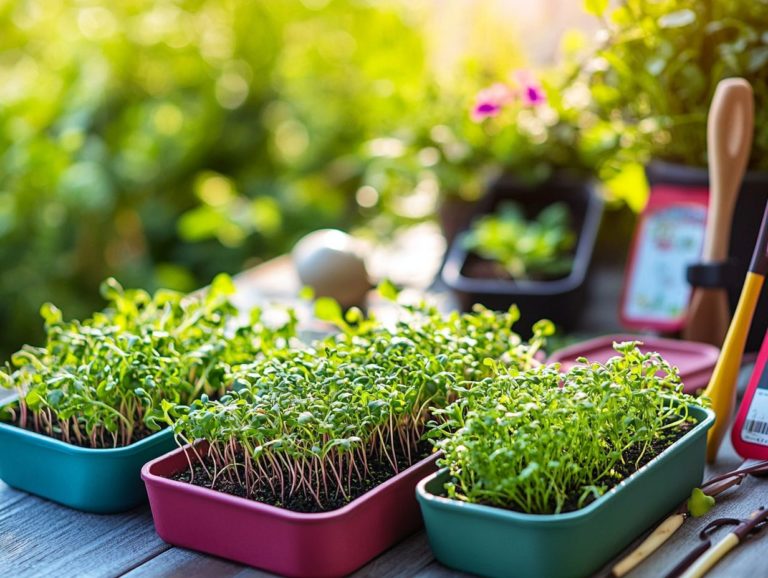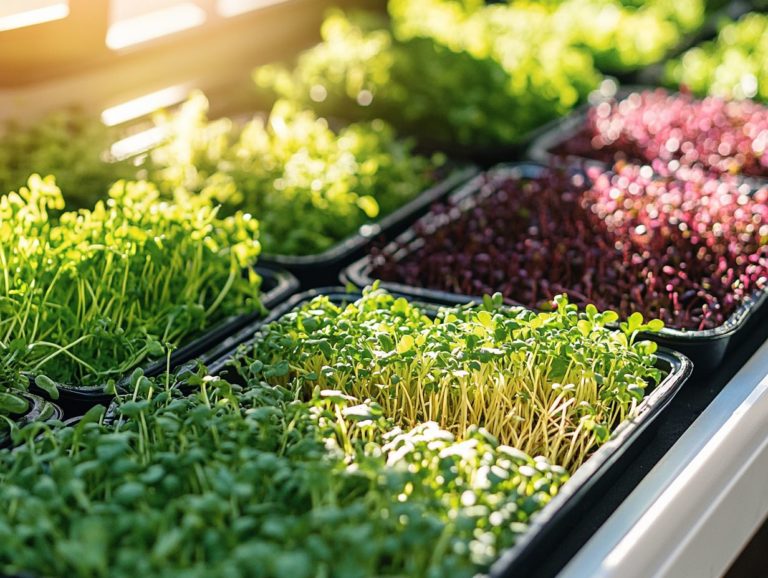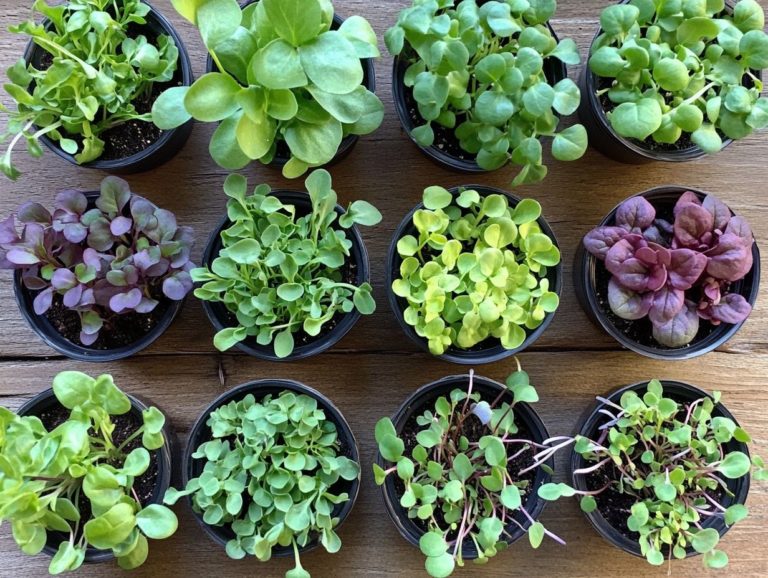Microgreen Varieties: The Science Behind Growth
Microgreens have truly revolutionized both the culinary and gardening landscapes. They provide an intense burst of flavor and nutrition packed into a tiny package, showcasing impressive nutritional properties.
These petite greens offer a remarkable punch, making them a highly sought-after addition to meals, salads, and various culinary uses.
Discover the myriad benefits of cultivating microgreens, from their impressive nutritional value to their cost-effectiveness, contributing to health-promoting diets.
Uncover the essential factors that influence their growth, explore popular varieties worth considering, and follow a comprehensive step-by-step guide to cultivate your own nutrient-rich seedlings at home.
You’ll also be equipped to tackle common challenges that may arise along the way. Immerse yourself and unveil the secrets to nurturing flourishing microgreens while ensuring optimal growing conditions!
Contents
Key Takeaways:
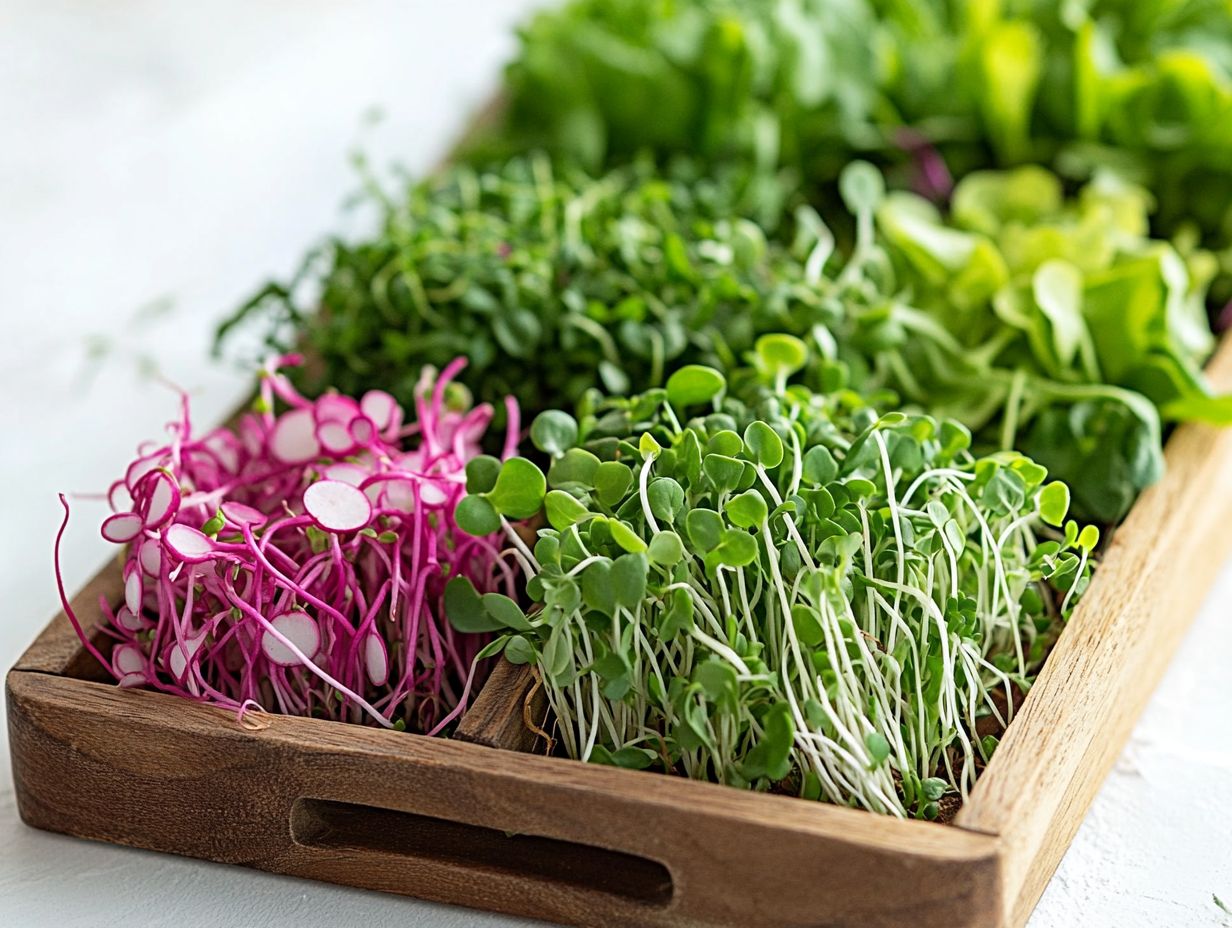
- Microgreens are nutrient-dense and cost-effective, making them a great addition to any diet.
- Light, temperature, and soil quality are crucial factors that affect the growth of microgreens.
- There are various types of microgreens with unique characteristics, such as arugula’s peppery flavor and sunflower’s nutty taste.
What are Microgreens?
Microgreens are the delightful young seedlings of various edible plant species, such as Swiss chard, broccoli, radish, cauliflower, arugula, cabbage, and kale. They are rich in chlorophyll and packed with nutrients. These nutrient-packed wonders have become a culinary sensation, celebrated for their vibrant flavors and remarkable health benefits.
These tiny powerhouses thrive in various growing conditions. They typically require a well-draining soil medium and ample exposure to bright light, along with attention to seed density. If you’re facing challenges, consider checking out troubleshooting common microgreen growth issues. Culinary enthusiasts can select from an array of varieties, including beet greens, mustard greens, and peas, to introduce unique flavors and textures to dishes.
With an astonishingly short growth cycle of just 7 to 21 days, these seedlings can elevate meals to gourmet status quickly. They enhance the visual appeal of salads and sandwiches, and their concentrated nutritional profiles support immune function and overall health. To learn more about this fascinating process, check out understanding microgreen growth cycles, making them an excellent choice for anyone aiming to boost their diet.
Benefits of Growing Microgreens
Growing microgreens provides an array of health benefits, enriching your diet in a way that aligns seamlessly with dietary guidelines.
Microgreens can help lower the risk of chronic diseases due to their rich antioxidant compounds. This makes them a valuable addition to your culinary repertoire.
Nutritional Value and Cost-Effectiveness
Microgreens are tiny powerhouses of nutrition, often packing in more vitamins, minerals, and antioxidants than their mature counterparts. This makes them a smart, cost-effective addition to a healthy diet, enhancing your intake of essential nutrients.
Many enthusiasts cherish these tiny greens for their vibrant flavors and impressive health benefits. For example, broccoli microgreens are thought to have potential cancer-fighting properties, while sunflower microgreens are brimming with healthy fats and protein. Understanding the role of temperature in microgreen growth can also enhance their cultivation.
While microgreens may come with a slightly higher price tag compared to traditional greens, their concentrated nutrients could lead to long-term health savings, enhancing your overall dietary quality. To learn more about the different options available, check out this quick guide to common microgreen varieties. This nutritional density means you can use less while still enjoying substantial health rewards, making them an excellent choice for anyone prioritizing their well-being.
Factors Affecting Microgreen Growth
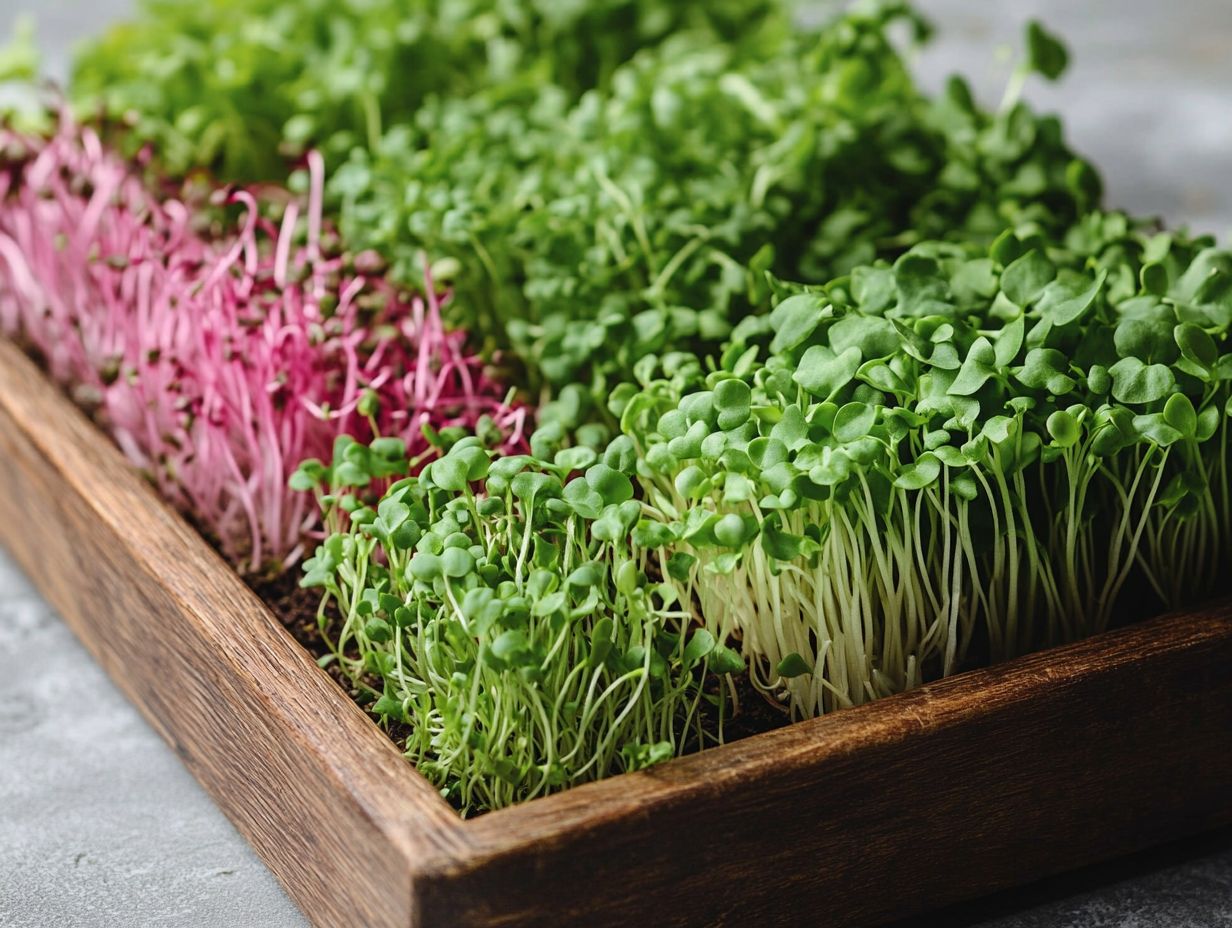
Several key factors influence the growth of microgreens that you should consider. The specific growing conditions, environmental needs, seed density, and the quality of the soil medium are all critical elements that play a vital role in successful cultivation.
Paying attention to these aspects will ensure your microgreens flourish.
Start growing your own microgreens today and transform your meals with vibrant flavors and health benefits!
Light, Temperature, and Soil Quality
The success of your microgreens hinges on a few key elements: adequate light exposure, optimal temperature, and high-quality soil. Each of these components plays a vital role in creating the perfect growing conditions.
These factors influence growth rate and significantly impact the flavor, nutritional content, and overall health benefits of your greens. For instance, providing the right amount of natural or artificial light allows those delicate seedlings to photosynthesize effectively, leading to robust development. Variations in temperature can affect seed germination and overall plant vigor, so careful monitoring is essential to maintain an ideal environment. To learn more about this, check out our guide on understanding microgreen growth phases.
In terms of soil quality, choosing specific mediums like coconut coir or peat moss can enhance drainage and nutrient availability, promoting the growth of healthy vegetable crops. Additionally, exploring seasonal microgreen varieties for year-round growth can further enrich your garden. By integrating these elements, you can quickly create an amazing space for vibrant plants!
Types of Microgreens
You ll find an impressive array of microgreens, each boasting its own distinct flavors and health benefits. Among the most sought-after varieties are Swiss chard, broccoli, radish, cauliflower, arugula, cabbage, and kale.
Each one not only enhances your dishes but also contributes to your well-being in delightful ways.
Popular Varieties and Their Unique Characteristics
Popular microgreens like Swiss chard, broccoli, and radish bring unique characteristics to your culinary repertoire, including their rich antioxidants and vitamins.
Take Swiss chard microgreens, for example, known for their vibrant color and rich chlorophyll content. They offer a slightly earthy flavor that’s perfect for elevating salads and sandwiches while boasting a rich content of vitamins A, C, and K. Understanding microgreen growth rates can help you optimize your growing process for these nutritious greens.
Then there’s broccoli microgreens, renowned for their mild, peppery taste and impressive nutritional profile, packed with antioxidant compounds and essential minerals like calcium and iron, making them a superb choice in health-promoting diets. To understand more about how these greens thrive, check out the science behind microgreen growth. Radish microgreens are hard to miss, with their sharp, spicy kick that adds a delightful zest to dishes like tacos and grain bowls.
Together, these petite greens don’t just enhance the taste of your meals; they deliver a treasure trove of health benefits that make them an essential addition to any kitchen, including the benefits of growing diverse microgreen varieties.
How to Grow Microgreens

Growing microgreens can be a remarkably simple endeavor when you adhere to a well-structured step-by-step guide and perform a germination test for optimal outcomes. This involves choosing the right microgreens growing kits, grasping the nuances of seed density, and performing a germination test to confirm seed viability among various microgreen seeds.
By following these essential steps, you can cultivate a thriving microgreens garden with ease.
Step-by-Step Guide for Successful Growth
To grow microgreens successfully, follow a clear, step-by-step guide that includes preparing the soil medium, testing germination, and ensuring optimal growing conditions.
- Start by selecting the right soil mix ideally one that s rich in organic matter. This promotes excellent drainage and aeration.
- It s crucial to maintain a seed density that gives each tiny plant enough space to thrive without overcrowding. Too many seeds in one spot can lead to mold and stunted growth.
- Before you sow, make sure the soil is evenly moistened and leveled to create the perfect foundation.
- Keep a close eye on light exposure, temperature, and humidity, as these factors are key to achieving the best results for your microgreens and their robust growth.
- Regularly checking moisture levels is equally important; too little or too much water can significantly impact your germination rates.
Troubleshooting Common Issues
Troubleshooting common issues like pests, mold, and other challenges is crucial for your success in microgreen cultivation. It requires a keen understanding of their specific environmental needs to ensure optimal growth and health.
Get started today and watch your garden thrive!
Addressing Pests, Mold, and Other Problems
Don t let pests or mold ruin your microgreens! Act now to safeguard your garden. Addressing pests, mold, and other common challenges in microgreen cultivation is essential for maintaining healthy growth.
To tackle these issues effectively, you must create a healthy space for your plants. Regularly monitor for pests and employ organic control methods like neem oil or insecticidal soap. Ensuring proper air circulation can significantly reduce these problems. Additionally, consider incorporating must-try microgreen varieties for salads to enhance your gardening experience.
Incorporating natural mold inhibitors, such as a simple mix of baking soda and water, will help keep the soil surface dry. By taking a proactive approach, you can create a thriving space for your microgreens while minimizing the risks associated with pests and mold.
Frequently Asked Questions
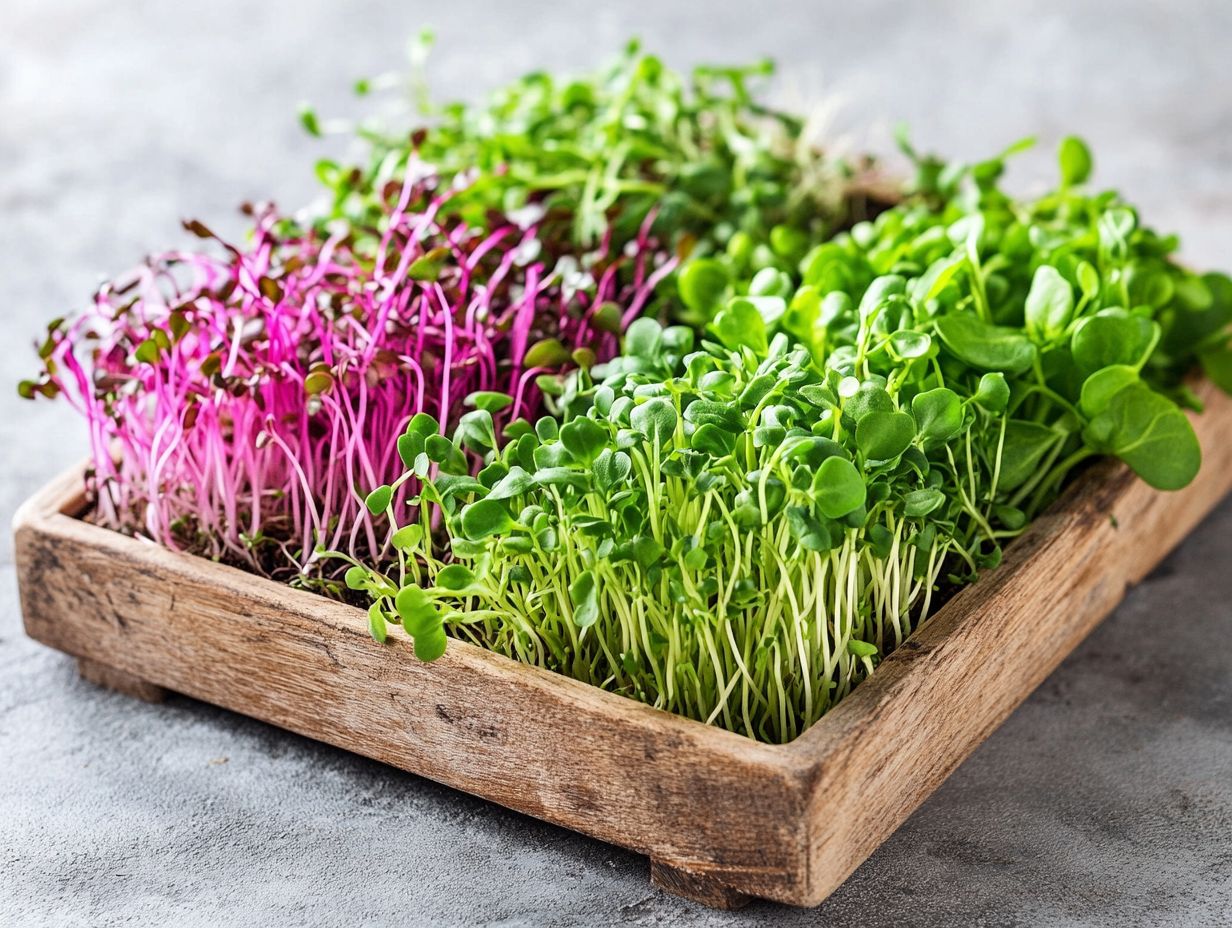
What are microgreens?
Microgreens are young vegetable plants harvested just after their first true leaves appear. They include various sprouts, herbs, and legumes, typically growing to 1-3 inches tall.
What are the different types of microgreens?
There are many types of microgreens available, each offering unique flavors and nutritional benefits. Popular varieties include broccoli, kale, arugula, radish, and pea shoots.
How do microgreens grow?
Microgreens thrive in a moist environment with plenty of light. Seeds are planted in a shallow container filled with a growing medium, such as soil or hydroponic mats, and kept in a warm, well-ventilated area.
What makes microgreens different from sprouts?
Microgreens and sprouts are often confused due to their small size, but they represent different stages of plant growth. Unlike sprouts, microgreens are grown in soil or a growing medium and are harvested after developing their first true leaves.
Are all microgreens safe to eat?
While most microgreens are safe, it’s important to research and correctly identify the variety before consumption. Some, like nightshade plants, can be toxic if consumed in large quantities.
What are the benefits of consuming microgreens?
Microgreens are packed with nutrients and antioxidants, making them a healthy addition to any diet. They are versatile and can be added to salads, sandwiches, and smoothies for a burst of flavor and nutrition.

